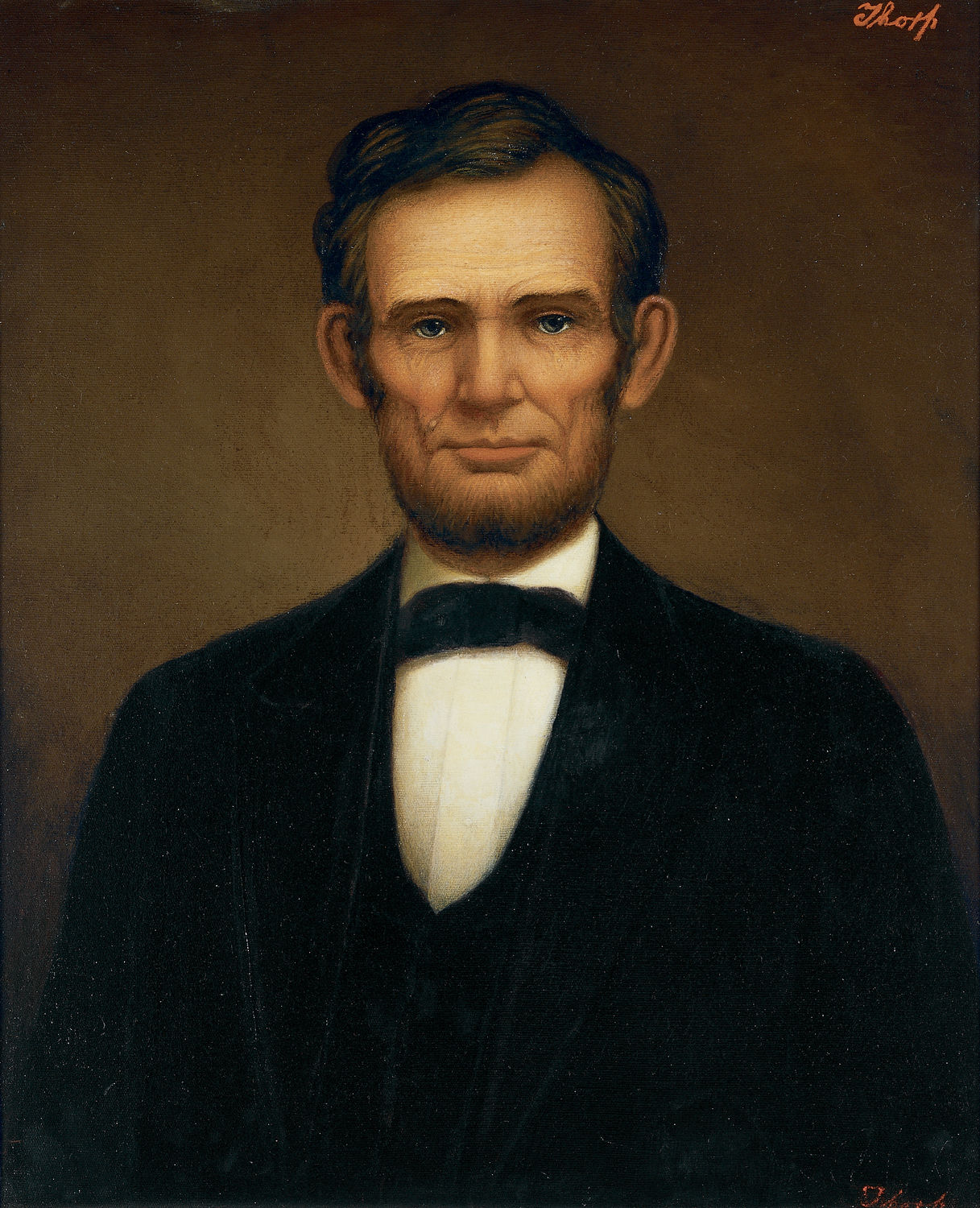
| Title | Abraham Lincoln |
| Artist/Maker | Freeman Thorp ( 1844 - 1922 ) |
| Date | 1879 ca.–1920 |
| Medium | Oil on canvas |
| Dimensions | Sight: h. 29.375 x w. 24.375 in. (h. 74.6125 x w. 61.9125 cm)
Framed: h. 39.875 x w. 34.25 in. (h. 101.2825 x w. 86.995 cm) |
| Credit Line | U.S. Senate Collection |
| Accession Number | 31.00008.000 |
According to artist Freeman Thorp, this portrait of Abraham Lincoln was originally executed in approximately 1879 from life sketches in a specially created studio on the fourth floor of the Senate wing of the U.S. Capitol. Four decades later the portrait was purchased from Thorp for the Capitol. At the time of its acquisition in 1920, Thorp described in a letter to the Joint Committee on the Library the intensity with which he had observed Lincoln: “I studied him very carefully and thoroughly from life just before his inauguration, and later at the White House and at Gettysburg when he made his famous address, sketching him, making a descriptive delineation such as artists use, memorizing his expression and how he looked when animated.” The artist believed that these observations allowed him to create an accurate portrait of the president, and that “it would be impracticable for any future portrait painter who had not known him in life to put the real Lincoln on canvas.”
By a Senate resolution approved April 5, 1920, the Joint Committee was directed “to engage an artist of reputation and ability to paint an oil portrait of the late Abraham Lincoln, former President of the United States, and to place the same in the Senate wing of the Capitol building, at a cost not to exceed $2,000.” [1] Several weeks later, the committee authorized payment of $2,000 to Freeman Thorp for his portrait of Lincoln. While an 1872 newspaper article acknowledged that some viewers considered Thorp’s portraits “too dark,” the writer suggested that this feature instead gives the works a “richness of tone,” lending facial expressions a “wonderful distinctness.” [2]
Over the years, Thorp painted a number of portraits of prominent Americans, including several other U.S. presidents. The Smithsonian Institution’s Inventory of American Painting and Sculpture lists 46 works by Thorp; eight of these, including the painting of Lincoln, are now held within the U.S. Capitol. Thorp’s other work in the Senate is the oil portrait of Assistant Doorkeeper Isaac Bassett.
1. Congressional Record (5 April 1920) vol. 59, pt. 5: 5180.
2. ”Thorp’s Photographs,” Washington, D.C. Daily Morning Chronicle, 12 February 1872.
Abraham Lincoln, 16th president of the United States, guided the nation through its devastating Civil War and remains much beloved and honored as one of the world's great leaders. Lincoln was born in Hardin (now Larue) County, Kentucky. He moved with his family to frontier Indiana in 1816, and then to Illinois in 1830. After serving four terms in the Illinois legislature, Lincoln was elected as a Whig to the U.S. House of Representatives in 1846. He did not seek reelection and returned to Springfield, Illinois, where he established a statewide reputation as an attorney. Although unsuccessful as a Whig candidate for the U.S. Senate in 1855, Lincoln was the newly formed Republican Party's standard-bearer for the same seat three years later. In that race, Lincoln captured national recognition by engaging Democrat Stephen A. Douglas in a dramatic series of public debates, but Lincoln ultimately lost to Douglas on election day.
In 1860 Lincoln was elected the nation's first Republican president. By the time of his inauguration in March 1861, seven Southern states had seceded from the Union, formed their own separate government, and inaugurated Jefferson Davis as its president. Concerned with preserving the Union from dissolution, Lincoln presented an inaugural address that was conciliatory in nature, assuring that slavery would not be abolished where it then existed. But one month later, when Confederate forces opened fire on Charleston's Fort Sumter while Congress was in recess, Lincoln acted decisively. He called up the militia; proclaimed a blockade; and suspended the writ of habeas corpus, which ensures a citizen's right to be brought before a court before imprisonment. The war that ensued lasted for four years, during which time Lincoln assumed greater executive power than any previous U.S. president.
Of all Lincoln's actions during the Civil War, he is perhaps best remembered for the Emancipation Proclamation, which he issued on January 1, 1863. Although it did not abolish slavery nationwide, it put slaveholders on notice and gave the conflict an undeniable moral imperative. When Lincoln was reelected in 1864, the war's end was in sight, and the president urged leniency toward the Southern states. His plan for postwar reconstruction advocated the forming of new state governments that would be loyal to the Union, a plan later adopted by President Andrew Johnson. Lincoln's presidency ended abruptly when he was shot by John Wilkes Booth on April 14, 1865, in Washington, D.C.'s Ford's Theatre. Lincoln died the following day.